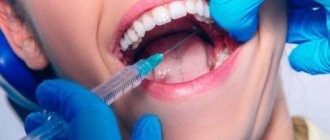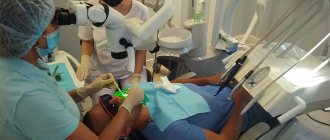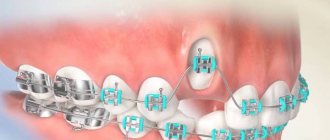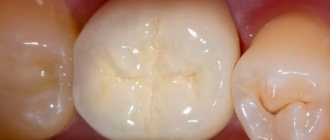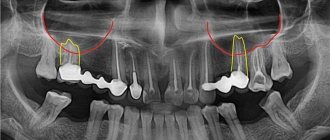Use of arsenic in dentistry
The paste, which is based on the oxide of this poison, has a destructive effect. Therefore, it can be used before removing the nerve. What are the properties of the paste?
- It has a fairly high degree of toxicity;
- It acts as a pain reliever;
- The mixture has a pronounced antibacterial effect;
- Its action is prolonged;
After a day or two, arsenic kills the nerve in the tooth. Patients with a low pain threshold do not feel pain during extraction of such a masticatory organ. It happens that the operation is performed after an injection with an anesthetic substance. Most often, the mass is laid for 1-2 days. The duration depends on the complexity of the pathology of the unit. It is extended when the multi-channel unit is disturbed.
To determine the duration of action of the drug, the doctor takes into account its composition. As a rule, more than half of the paste consists of anesthetic components and anhydride, which has a necrotic effect. Also, antiseptics, tannin for binding ingredients, and fillers are added to the mass.
How harmful is it?
Arsenic is a poison, but in dentistry it is used in very small doses and is not dangerous when used correctly. The instructions for use state that the maximum dose should not exceed 0.0008 g.
The main tasks are to take precautions, inject the drug into the tooth pulp without introducing dirt, and monitor the health and the body’s reaction to the substance.
If arsenic begins to kill healthy tissue, then even after its removal some of the paste will remain, later leading to inflammation.
Indications and contraindications
The paste is used in cases where it is impossible to use modernly produced anesthetics. Such situations occur in certain indications:
- The patient is allergic to other anesthetics;
- If you need to urgently kill nerve fibers and remove a molar;
- When the patient cannot tolerate anesthesia for health reasons;
- Urgent treatment of patients with acute pain;
- Treatment of incisors, canines, molars in childhood when it is impossible to use local anesthesia;
Of course, like every drug, the paste has contraindications. The doctor must take them into account.
- It is impossible to put mass into a pathological tooth if the patient is under two years old.
- Keeping the paste is not allowed in case of chronic kidney disease or prostate disease.
- If the tooth canals are curvature, another remedy is used.
- The paste is not used at the moment of resorption of the roots of the chewing organs.
- This method is not used for glaucoma and allergies to components.
Possible complications when installing a filling
Most often, when installing a filling, complications arise if the arsenic is overexposed or the dose is incorrectly calculated. It is possible that:
- dentin turns black;
- the pulp swells;
- the tissues around the tooth become inflamed;
- the process of necrosis of the periosteum and bone starts;
- the body is in the stage of general poisoning.
Most often, when installing a filling, complications arise if the arsenic is overexposed or the dose is incorrectly calculated. It is possible that...
Dentists use arsenic when treating teeth. The doctor himself removes the temporary filling with this substance from the carious cavity. But patients do not always have the opportunity to seek help from a specialist. Since such a remedy is a strong poison, you need to know how to remove arsenic from a tooth yourself so that irreversible changes do not begin.
How is the treatment carried out?
To treat a diseased tooth or have it removed, during the first visit the dentist sends the patient for an x-ray. Based on the diagnostic results, further procedures are determined. Neglected masticatory organs are subject to extraction, to which it is useless to apply conservative therapy. Often the treatment regimen includes nerve removal and filling.
- First, the dentist opens the pulp, cleans the pathological cavity, removing dead tissue from it.
- The cavity is then filled with the required amount of paste.
- A cotton ball soaked in a phenol solution is placed on top of this layer.
- After this, a temporary soft filling is installed.
The patient is scheduled for a next visit. The doctor recommends refraining from eating for at least two hours and not pressing on the pathological unit. On the second visit, the dentist:
- remove the filling;
- will remove arsenic;
- cleans the cavity of the chewing organ;
- will painlessly remove a nerve that died under the influence of poison;
- install permanent filling material;
Self-removal of arsenic paste from a tooth
If it is not possible to visit the dentist and get the medicine in a hospital setting, then you should take the medicine out with your own hands, which should be washed. Before starting the procedure, the oral cavity must be thoroughly cleaned. To remove it, you will need a toothpick with the tip treated with alcohol.
When the temporary filling is successfully removed, a grayish arsenic paste is also removed. This must be treated carefully, as it should not crumble. After completely cleaning the tooth, rinse your mouth with chamomile solution. Subsequent treatment must be done by a doctor, otherwise the damaged tooth will be destroyed.
Possible side effects
Arsenic is placed in the tooth so that it deadens the nerve. But its action can cause complications. How dangerous is this? If you consult an experienced doctor who will use not pure poison, but its derivative, there is nothing to worry about. The paste is placed deeply and sealed on top, so it does not enter the stomach. High doses of the substance and its untimely removal are harmful. In this case, there is a risk of inflammation, periostitis, periodontitis. Continuing to walk with poison longer than prescribed is dangerous! After all, prolonged contact with tissues poisons the body. Untimely removal and excessive dose cause:
- Darkening of dentin;
- Inflammation of the tissues surrounding the unit;
- Pulp swelling, pulpitis;
- Necrosis of bone tissue and periosteum;
- General intoxication; poisoning of the body.
Sometimes it happens that the pain becomes stronger and becomes tearing. This happens when the dose of the substance is too small or the threshold of vulnerability is high, as well as with necrosis of the periosteum and individual intolerance.
For adults
For a conditionally healthy adult, the drug is prescribed for a period of 1 to 2 days. In this case, an important role is played by the fact on which tooth the arsenic paste is installed, as well as what treatment method is used. Arsenic balls can be placed either on top of the closed pulp or inside after it has been opened.
For 2 days, the paste is placed in a tooth with 2 roots, since it is necessary to remove a larger number of nerve endings, but in other cases, 24 hours is enough.
Children are more susceptible to poisons, so young patients under 18 years of age are given arsenic for less than a day. Typically, the time allotted for arsenic to act in a child’s body is from 16 to 24 hours. Therefore, it is extremely important for parents to take their child to the next appointment on time.
Arsenic during pregnancy and in pediatric dentistry
Often, tooth root removal is required for pregnant women or children. During pregnancy and the appearance of milk units, the paste is used very rarely.
- Firstly, the issue of the effect of toxins on the delicate roots of temporary teeth and the embryo has not been sufficiently studied.
- Secondly, it is difficult to correctly calculate the tiny dose for children.
- Thirdly, a child may accidentally swallow the fallen paste.
Therefore, the substance is used only as a last resort when the patient is allergic to anesthesia. Due to high risks, the toxic substance is replaced with a safe one. When the pediatric dentist is forced to use the paste, its action time is reduced to a minimum. In other cases, alternative pulp necrotization technologies are used.
Features of using the drug
The dose of arsenic used in dentistry does not cause serious harm to the body, but it does affect the structure of the dental system. The product is placed on the tooth to kill the nerve to protect against subsequent pain. A small amount of the drug used for the right time is safe for the patient.
However, before this procedure, the specialist is obliged to check the patient for contraindications to the use of this therapy. Despite their small number, the dentist must take into account all the features of using arsenic individually for each patient.
There are the following contraindications for using the drug:
- The existence of serious problems with the genitourinary system.
- Intolerance to any elements of arsenic paste.
- Children of age , pregnancy and breastfeeding.
- The restricted path to the canals and the absence of the possibility of local use of arsenic.
Many treatment processes in dentistry are performed with arsenic paste. Most often, it eliminates severe pain when removing deep caries that has reached the pulp. Before treatment, the specialist must inform the patient about the purpose of arsenic and the amount of time the product remains on the tooth.
To fix the paste, a temporary filling is placed on the treated area. When the prescribed period expires, the doctor removes the arsenic and continues treatment. Two days are enough to kill the nerve.
The maximum duration of use of the drug is one week. If the product is not removed on time, it begins to have a detrimental effect on the state of the microflora inside the tooth and its activity. If the paste falls out on its own, you should not hesitate to visit a doctor.
What is nerve removal?
As you know, a tooth is not just bone tissue. Each tooth has nerve endings located in the pulp chamber. It is when exposed to a bundle of nerve endings and blood vessels that a person experiences discomfort and pain. Removing the nerve leads to the fact that the supply of nutrients to the tooth tissues stops, and the tooth gradually dies.
When we hear about nerve removal, we are talking specifically about the pulp chamber. It is this area of the tooth that is responsible for the reaction to any mechanical and temperature stimuli. After removal, the tooth will no longer react to cold and hot, the patient will no longer complain of discomfort when food particles get on the tooth.
Over time, a tooth without pulp may change color, become dull, and more fragile than before. However, despite all these consequences, sometimes removing the nerve is a necessary procedure. It allows you to reduce pain and do without implantation - removing a tooth and replacing it with an artificial pin with a crown.
Does it hurt or not?
The sensitivity of teeth is provided by a nerve that is located in the pulp tissue. For this reason, both the pathology itself and the process of its elimination presuppose the presence of pain.
Dentistry has ample opportunities for painless treatment of pulpitis. Anesthesia is used for this. Modern drugs are safe and do not pose a risk to the child’s health.
Methods of dental anesthesia.
- Local anesthesia. An anesthetic is injected into the soft tissues, eliminating any sensation for a certain period of time. To ensure that the child does not feel the injection, topical anesthesia is additionally used.
- Sedation. The method is also called “medicated sleep.” Pain relief is achieved by placing the child under a mild general anesthesia. To administer the anesthetic, intravenous and inhalation methods are used. The duration of anesthesia is from 10 minutes to 2 hours.
When treating young children under 5 years of age, dentists give preference to medicated sleep. It is difficult for a child to simultaneously cope with fear and maintain a calm position, which can complicate the procedure and cause tissue injury. Sedation allows you to eliminate psychological trauma and any painful sensations, as well as make the dentist’s work easier and speed up the treatment process.
What symptoms should you contact your dentist for?
Ideally, you should visit the dental clinic with your child every six months, and if signs of caries appear, treatment should begin immediately. But more often, parents turn to specialists when their child begins to suffer from severe toothache.
You should make an appointment with a dentist if your child exhibits the following symptoms:
- feeling of bursting and dull toothache;
- reduction of pain after eating hot food or during sleep;
- tooth sensitivity when eating;
- purulent odor from the mouth even after brushing your teeth;
- extensive carious cavity;
- other damage to the dental crown.
Pulpitis is characterized by rapid progression of the inflammatory process. If the nerve is removed at the initial stage, there will be no complications. In advanced cases, the pathological process can develop into a cystic or granulomatous form, or the infection begins to spread to the jaw bones or sinus tissue.
Indications for nerve removal
According to statistics, the main reason for removing the nerve of a tooth is advanced pulpitis, that is, carious tissue damage. If this pathology is ignored and left untreated for a long time, the enamel and deeper layers of dentin are destroyed, and the nerve may be exposed. As a result, the patient may complain of unbearable pain at the slightest contact with the tooth.
As a rule, removal of a nerve is a consequence of a neglectful attitude towards one’s health and the health of one’s teeth. Carious holes that are left untreated for a long period of time lead to pulp damage. That is why experts strongly recommend regularly visiting the clinic for preventive examinations.
In this case, the removal of the nerve can be either complete or partial. This depends on the degree of damage to the tooth and the possibility of further treatment, but the final decision is always made by the attending dentist after examination. Usually, partial removal can be limited to cases where the inflammatory process has affected only the top of the pulp chamber. In this case, only dead tissue will be extracted.
